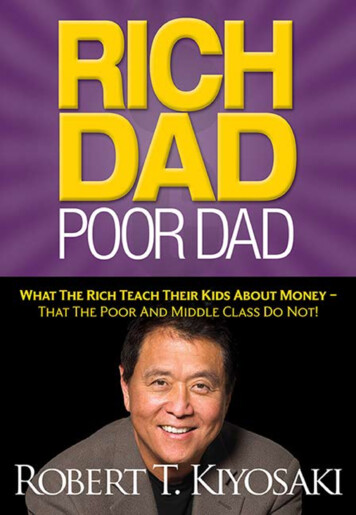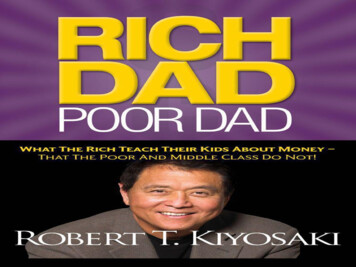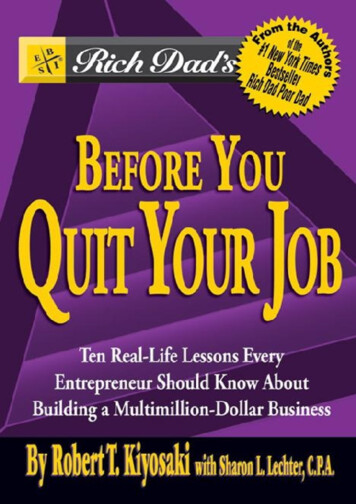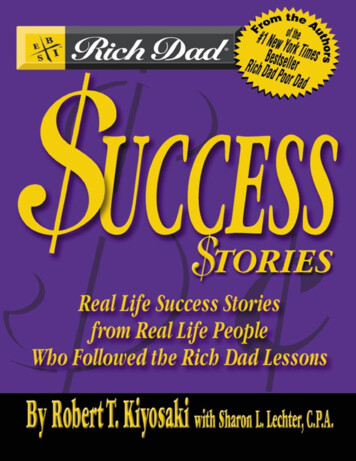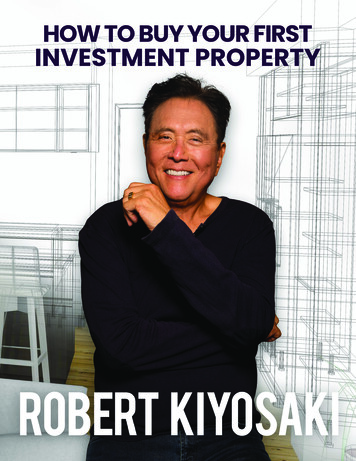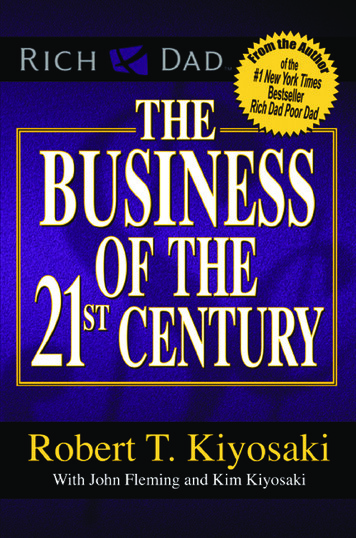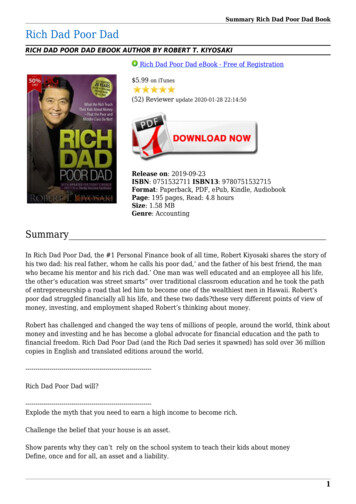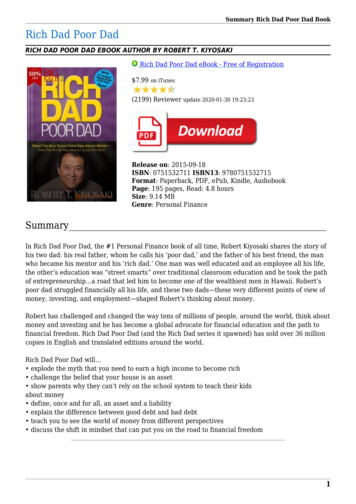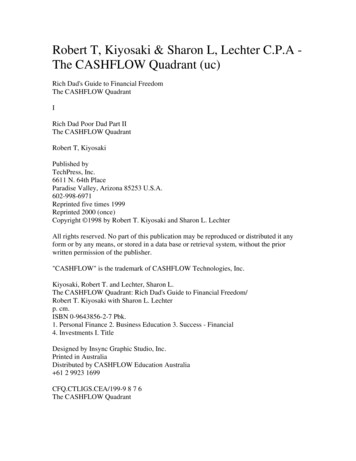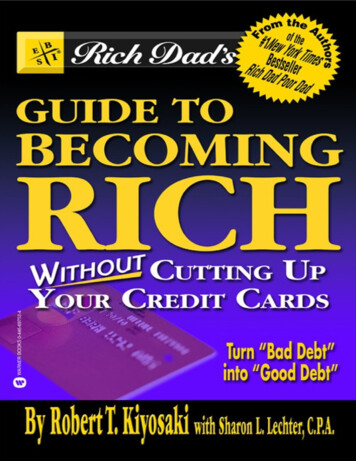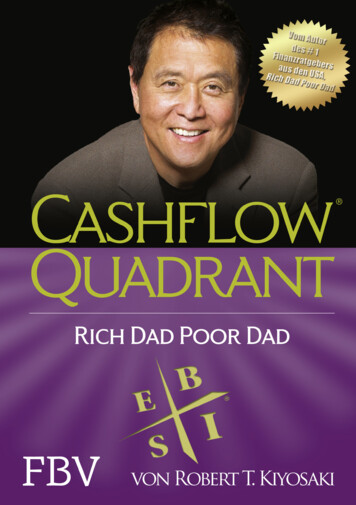
Transcription
Rich Dad'sCashflowquadrantGuide to Financial FreedomBy Robert T. Kiyosaki
Rich Dad'sCashflowquadrant Guide to Financial FreedomBy Robert T. Kiyosaki
If you purchase this book without a cover, or purchase a PDF, jpg, or tiff copy of this book,it is likely stolen property or a counterfeit. In that case, neither the authors, the publisher,nor any of their employees or agents has received any payment for the copy. Furthermore,counterfeiting is a known avenue of financial support for organized crime and terroristgroups. We urge you to please not purchase any such copy and to report any instance ofsomeone selling such copies to Plata Publishing LLC.This publication is designed to provide competent and reliable information regarding thesubject matter covered. However, it is sold with the understanding that the author andpublisher are not engaged in rendering legal, financial, or other professional advice. Lawsand practices often vary from state to state and country to country and if legal or otherexpert assistance is required, the services of a professional should be sought. The authorand publisher specifically disclaim any liability that is incurred from the use or applicationof the contents of this book.Copyright 1998, 2012 by Robert T. Kiyosaki. All rights reserved. Except as permittedunder the U.S. Copyright Act of 1976, no part of this publication may be reproduced,distributed, or transmitted in any form or by any means or stored in a database or retrievalsystem, without the prior written permission of the publisher.Published by Plata Publishing, LLCCASHFLOW, Rich Dad, and CASHFLOW Quadrant are registered trademarks ofCASHFLOW Technologies, Inc.is a registered trademark ofCASHFLOW Technologies, Inc.Plata Publishing, LLC4330 N. Civic Center PlazaSuite 100Scottsdale, AZ 85251(480) 998-6971Visit our websites: PlataPublishing.com and RichDad.comPrinted in the United States of America042014First Edition: 1998First Plata Publishing Edition: August 2011ISBN: 978-1-61268-005-7Cover photo credit: Seymour & Brody Studio
Best-selling Booksby Robert T. KiyosakiRich Dad Poor DadWhat the Rich Teach Their Kids About Money –That the Poor and Middle Class Do NotRich Dad’s CASHFLOW QuadrantGuide to Financial FreedomRich Dad’s Guide to InvestingWhat the Rich Invest in That the Poor and Middle Class Do NotRich Dad’s Rich Kid Smart KidGive Your Child a Financial Head StartRich Dad’s Retire Young Retire RichHow to Get Rich and Stay RichRich Dad’s ProphecyWhy the Biggest Stock Market Crash in History Is Still Coming.And How You Can Prepare Yourself and Profit from It!Rich Dad’s Success StoriesReal-Life Success Stories from Real-Life PeopleWho Followed the Rich Dad LessonsRich Dad’s Guide to Becoming RichWithout Cutting Up Your Credit CardsTurn Bad Debt into Good DebtRich Dad’s Who Took My Money?Why Slow Investors Lose and Fast Money Wins!Rich Dad Poor Dad for TeensThe Secrets About Money – That You Don’t Learn In School!Escape the Rat RaceLearn How Money Works and Become a Rich KidRich Dad’s Before You Quit Your JobTen Real-Life Lessons Every Entrepreneur Should KnowAbout Building a Multimillion-Dollar BusinessRich Dad’s Increase Your Financial IQGet Smarter with Your MoneyRobert Kiyosaki’s Conspiracy of the RichThe 8 New Rules of MoneyUnfair AdvantageThe Power of Financial EducationWhy “A” Students Work for “C” StudentsRich Dad’s Guide to Financial Education for Parents
My rich dad used to say,“You can never have true freedom without financial freedom.”He would go on to say,“Freedom may be free, but it has a price.”This book is dedicated to those who are willing to pay the price.
Editor’s NoteThe Times They Are A-Changin’There have been many changes in our economy and the investinglandscape since Rich Dad Poor Dad was first published in 1997. Fourteenyears ago, Robert Kiyosaki challenged conventional wisdom with hisbold statement that “your house is not an asset.” His contrarian views onmoney and investing were met with skepticism, criticism, and outrage.In 2002, Robert’s book, Rich Dad’s Prophecy, advised that we prepare foran upcoming financial market crash. In 2006, Robert joined forces withDonald Trump to write Why We Want You To Be Rich, a book inspired bytheir concern for the shrinking middle class in America.Robert continues to be a passionate advocate for the importance andpower of financial education. Today, in the wake of the subprime fiasco,record home foreclosures, and a global economic meltdown that isstill raging, his words seem not only prophetic, but enlightened. Manyskeptics have become believers.In preparing the 2011 edition of Rich Dad’s CASHFLOW Quadrant,Robert realized two things: that his message and teachings have withstoodthe test of time, and that the investment landscape, the world in whichinvestors operate, has changed dramatically. These changes have affected,and will continue to affect, those in the I (Investor) quadrant and havefueled Robert’s decision to update an important section in this book—Chapter Five: The Five Levels of Investors.
ContentsINTRODUCTIONWhich Quadrant Are You In?. 1Part OneThe CASHFLOW QuadrantChapter OneWhy Don’t You Get a Job?. 11Chapter TwoDifferent Quadrants, Different People. 23Chapter ThreeWhy People Choose Security over Freedom. 57Chapter FourThe Three Kinds of Business Systems. 81Chapter FiveThe Five Levels of Investors. 95Chapter SixYou Cannot See Money with Your Eyes. 119Part TwoBringing Out the Best in YouChapter SevenBecoming Who You Are. 149Chapter EightHow Do I Get Rich?. 165Chapter NineBe the Bank, Not the Banker. 187Part ThreeHow To Become a Successful B and IChapter TenTake Baby Steps. 217The Seven Steps to Finding Your Financial Fast TrackChapter ElevenStep 1: It’s Time to Mind Your Own Business. 233Chapter TwelveStep 2: Take Control of Your Cash Flow. 239Chapter Thirteen Step 3: Know the Difference Between Risk and Risky. 247Chapter Fourteen Step 4: Decide What Kind of Investor You Want to Be. 251Chapter FifteenStep 5: Seek Mentors. 259Chapter SixteenStep 6: Make Disappointment Your Strength . 269Chapter Seventeen Step 7: The Power of Faith. 275Chapter Eighteen In Summary. 281
PrefaceWhat is yourLife's goal?“What do you want to be when you grow up?” That is a questionmost of us have been asked.I had many interests as a kid, and it was easy to choose. If itsounded exciting and glamorous, I wanted to do it. I wanted to bea marine biologist, an astronaut, a Marine, a ship’s officer, a pilot,and a professional football player.I was fortunate enough to achieve three of those goals: a MarineCorps officer, a ship’s officer, and a pilot.I knew I did not want to become a teacher, a writer, or an accountant.I did not want to be a teacher because I did not like school. I did notwant to be a writer because I failed English twice. And I dropped out ofmy MBA program because I could not stand accounting.Ironically, now that I have grown up, I have become everythingI never wanted to become. Although I disliked school, today I own aneducation company. I personally teach around the world because I loveteaching. Although I failed English twice because I could not write,today I am best known as an author. My book, Rich Dad Poor Dad, wason the New York Times best-sellers list for over seven years and is one ofthe top three best-selling books in the United States. The only booksahead of it are The Joy of Sex and The Road Less Traveled. Adding onemore irony, Rich Dad Poor Dad and my CASHFLOW board game area book and a game about accounting, another subject I struggled with.So what does this have to do with the question: “What is your goalin life?”xv
PrefaceThe answer is found in the simple, yet profound, statement bya Vietnamese monk, Thich Naht Hahn: “The path is the goal.” Inother words, finding your path in life is your goal in life. Your path isnot your profession, how much money you make, your title, or yoursuccesses and failures.Finding your path means finding out what you were put here onthis earth to do. What is your life’s purpose? Why were you given thisgift called life? And what is the gift you give back to life?Looking back, I know going to school was not about finding mylife’s path. I spent four years in military school, studying and trainingto be a ship’s officer. If I had made a career sailing for Standard Oilon their oil tankers, I would never have found my life’s path. If I hadstayed in the Marines or had gone to fly for the airlines, I would neverhave found my life’s path.Had I continued on as a ship’s officer or become an airline pilot, Iwould never have become an international best-selling author, been aguest on the Oprah show, written a book with Donald Trump, or startedan international education company that teaches entrepreneurship andinvesting throughout the world.Finding Your PathThis CASHFLOW Quadrant book is important because it is aboutfinding your path in life. As you know, most people are programmedearly in life to “Go to school and get a job.” School is about finding ajob in the E or S quadrant. It is not about finding your life’s path.I realize there are people who know exactly what they are goingto do early in life. They grow up knowing they are going to be adoctor, lawyer, musician, golfer or actor. We have all heard about childprodigies, kids with exceptional talents. Yet you may notice, these areprofessions, not necessarily a life’s path.xvi
CASHFLOW QuadrantSo How Does One Find Their Path in Life?My answer is: I wish I knew. If I could wave my magic wand andyour life’s path would magically appear, I would.Since I do not have a magic wand nor can I tell you what to do,the best thing I can do is tell you what I did. And what I did was trustmy intuition, my heart, and my guts. For example, in 1973, returningfrom the war, when my poor dad suggested I go back to school, getmy higher degrees, and work for the government, my brain wentnumb, my heart went heavy and my gut said, “No way.”When he suggested I get my old job back with Standard Oil or flyfor the airlines, again my mind, heart, and gut said no. I knew I wasthrough sailing and flying, although they were great professions andthe pay was pretty good.In 1973 at the age of 26, I was growing up. I had followed myparent’s advice and gone to school, received my college degree, andhad two professions: a license to be a ship’s officer and a license to fly.The problem was, they were professions and the dreams of a child.At the age of 26, I was old enough to know that education is aprocess. For example, when I wanted to be a ship’s officer, I went to aschool that turned out ships’ officers. And when I wanted to learn tofly, I went to Navy flight school, a two-year process that turns nonpilots into pilots. I was cautious about my next educational process. Iwanted to know what I was going to become before I started my nexteducational process.Traditional schools had been good to me. I had achieved mychildhood professions. Reaching adulthood was confusing becausethere were no signs saying, “This is the way.” I knew what I didn’twant to do, but I did not know what I wanted to do.It would have been simple if all I wanted was a new profession.If I had wanted to be a medical doctor, I would have gone to medicalschool. If I had wanted to be a lawyer, I would have gone to lawschool. But I knew there was more to life than just going to school togain another professional credential.I did not realize it at the time, but at 26 years of age, I was nowlooking for my path in life, not my next profession.xvii
PrefaceA Different EducationIn 1973, in my last year of active duty flying for the MarineCorps when I was stationed near home in Hawaii, I knew I wantedto follow in my rich dad’s footsteps. While in the Marines, I signedup for real estate courses and business courses on the weekends,preparing to become an entrepreneur in the B and I quadrants.At the same time, upon a friend’s recommendation of a friend,I signed up for a personal-development course, hoping to find outwho I really was. A personal-development course is non-traditionaleducation because I was not taking it for credits or grades. I did notknow what I was going to learn, as I did when I signed up for realestate courses. All I knew was that it was time to take courses to findout about me.In my first weekend course, the instructor drew this simplediagram on the flip chart:PHYSICALMENTALEMOTIONALSPIRITUALWith the diagram complete, the instructor turned and said,“To develop into a whole human being, we need mental, physical,emotional, and spiritual education.”xviii
CASHFLOW QuadrantListening to her explanation, it was clear to me that traditionalschools were primarily about developing students mentally. That iswhy so many students who do well in school, do not do well in reallife, especially in the world of money.As the course progressed over the weekend, I discovered why Idisliked school. I realized that I loved learning, but hated school.Traditional education was a great environment for the “A” students,but it was not the environment for me. Traditional education wascrushing my spirit, trying to motivate me with the emotion of fear: thefear of making mistakes, the fear of failing, and the fear of not gettinga job. They were programming me to be an employee in the E or Squadrant. I realized that traditional education is not the place for aperson who wants to be an entrepreneur in the B and I quadrants.This may be why so many entrepreneurs never finish school—entrepreneurs like Thomas Edison, founder of General Electric;Henry Ford, founder of Ford Motor Company; Steve Jobs, founderof Apple; Bill Gates, founder of Microsoft; Walt Disney, founder ofDisneyland; and Mark Zuckerberg, founder of Facebook.As the day went on and the instructor went deeper and deeper intothese four types of personal development, I realized I had spent mostof my life in very harsh educational environments. After four years atan all-male military academy and five years as a Marine pilot, I waspretty strong mentally and physically. As a Marine pilot, I was strongemotionally and spiritually, but all on the macho-male developmentside. I had no gentle side, no female energy. After all, I was trained tobe Marine Corps officer, emotionally calm under pressure, prepared tokill, and spiritually prepared to die for my country.If you ever saw the movie Top Gun starring Tom Cruise, you geta glimpse into the masculine world and bravado of military pilots.I loved that world. I was good in that world. It was a modern-dayworld of knights and warriors. It was not a world for wimps.In the seminar, I went into my emotions and briefly touched myspirit. I cried a lot because I had a lot to cry about. I had done andseen things no one should ever be asked to do. During the seminar,xix
PrefaceI hugged a man, something I had never done before, not even withmy father.On Sunday night, it was difficult leaving this self-developmentworkshop. The seminar had been a gentle, loving, honest environment.Monday morning was a shock to once again be surrounded by youngegotistical pilots, dedicated to flying, killing and dying for country.After that weekend seminar, I knew it was time to change. I knewdeveloping myself emotionally and spiritually to become a kinder,gentler, and more compassionate person would be the hardest thingI could do. It went against all my years at the military academy andflight school.I never returned to traditional education again. I had no desireto study for grades, degrees, promotions, or credentials again. Fromthen on, if I did attend a course or school, I went to learn, to becomea better person. I was no longer in the paper chase of grades, degrees,and credentials.Growing up in a family of teachers, your grades, the high schooland college you graduated from, and your advanced degrees wereeverything. Like the medals and ribbons on a Marine pilot’s chest,advanced degrees and brand-name schools were the status and thestripes that educators wore on their sleeves. In their minds, peoplewho did not finish high school were the unwashed, the lost souls oflife. Those with master’s degrees looked down on those with onlybachelor degrees. Those with a PhD were held in reverence. At theage of 26, I knew I would never return to that world.Editor’s Note: In 2009, Robert received an honorary PhD inentrepreneurship from prestigious San Ignacio de Loyola inLima, Peru. The few other recipients of this award are politicalleaders, such as the former President of Spain.xx
CASHFLOW QuadrantFinding My PathI know some of you are now asking: Why is he spending so muchtime talking about non-traditional education courses?The reason is, that first personal-development seminar rekindledmy love of learning, but not the type of learning that is taught inschool. Once that seminar was over, I became a seminar junkie, goingfrom seminar to seminar, finding out more about the connectionbetween my body, my mind, my emotions, and my spirit.The more I studied, the more curious about traditional educationI became. I began to ask questions such as: Why do so many kids hate school? Why do so few kids like school? Why are many highly educated people not successfulin the real world? Does school prepare you for the real world? Why did I hate school but love learning? Why are most schoolteachers poor? Why do schools teach us little about money?Those questions led me to become a student of education outsidethe hallowed walls of the school system. The more I studied, the moreI understood why I did not like school and why schools failed to servemost of its students, even the “A” students.My curiosity touched my spirit, and I became an entrepreneurin education. If not for this curiosity, I might never have become anauthor and a developer of financial-education games. My spiritualeducation led me to my path in life.It seems that our paths in life are not found in our minds. Ourpath in life is to find out what is in our hearts.This does not mean a person cannot find their path in traditionaleducation. I am sure many do. I am just saying that I doubt I wouldhave found my path in traditional school.xxi
PrefaceWhy Is a Path Important?We all know people who make a lot of money, but hate theirwork. We also know people who do not make a lot of money andhate their work. And we all know people who just work for money.A classmate of mine from the Merchant Marine Academy alsorealized he did not want to spend his life at sea. Rather than sail forthe rest of his life, he went to law school after graduation, spendingthree more years becoming a lawyer and entering private practice inthe S quadrant.He died in his early fifties. He had become a very successful,unhappy lawyer. Like me, he had two professions by the time he was26. Although he hated being a lawyer, he continued being a lawyerbecause he had a family, kids, a mortgage, and bills to pay.A year before he died, I met him at a class reunion in New York.He was a bitter man. “All I do is sweep up behind rich guys like you.They pay me nothing. I hate what I do and who I work for.”“Why don’t you do something else?” I asked.“I can’t afford to stop working. My first child is entering college.”He died of a heart attack before she graduated.He made a lot of money via his professional training, but he wasemotionally angry, spiritually dead, and soon his body followed.I realize this is an extreme example. Most people do not hate whatthey do as much as my friend did. Yet it illustrates the problem whena person is trapped in a profession and unable to find their path.To me, this is the shortcoming of traditional education. Millionsof people leave school, only to be trapped in jobs they do not like.They know something is missing in life. Many people are also trappedfinancially, earning just enough to survive, wanting to earn more butnot knowing what to do.Without awareness of the other quadrants, many people go backto school and look for new professions or pay raises in the E or Squadrant, unaware of the world of the B and I quadrants.xxii
CASHFLOW QuadrantMy Reason for Becoming a TeacherMy primary reason for becoming a teacher in the B quadrant was adesire to provide financial education. I wanted to make this educationavailable to anyone who wanted to learn, regardless of how much moneythey had or what their grade-point averages were. That is why The RichDad Company started with the CASHFLOW game. This game can teachin places I could never go. The beauty of the game is that it was designedto have people teach people. There is no need for an expensive teacheror classroom. The CASHFLOW game is now translated into over sixteenlanguages, reaching millions of people all over the world.Today, The Rich Dad Company offers financial-education courses aswell as the services of coaches and mentors to support a person’s financialeducation. Our programs are especially important for anyone wanting toevolve out of the E and S quadrants into the B and I quadrants.There is no guarantee that everyone will make it to the B and Iquadrants, yet they will know how to access those quadrants if theywant to.Change Is Not EasyFor me, changing quadrants was not easy. It was hard work mentally,but more so emotionally and spiritually. Growing up in a family ofhighly educated employees in the E quadrant, I carried their values ofeducation, job security, benefits, and a government pension. In manyways, my family values made my transition difficult. I had to shut outtheir warnings, concerns, and criticisms about becoming an entrepreneurand investor. Some of their values I had to discount were: “But you have to have a job.” “You’re taking too many risks.” “What if you fail?” “Just go back to school and get your masters degree.” “Become a doctor. They make a lot of money.” “The rich are greedy.”xxiii
Preface “Why is money so important to you?” “Money won’t make you happy.” “Just live below your means.” “Play it safe. Don’t go for your dreams.”Diet and ExerciseI mention emotional and spiritual development because that iswhat it takes to make a permanent change in life. For example, itrarely works to tell an overweight person, “Just eat less and exercisemore.” Diet and exercise may make sense mentally, but most peoplewho are overweight do not eat because they are hungry. They eat tofeed an emptiness in their emotions and their soul. When a persongoes on a diet-and-exercise program, they are only working on theirmind and their body. Without emotional development and spiritualstrength, the overweight person may go on a diet for six monthsand lose a ton of weight, only to put even more weight back on later.The same is true for changing quadrants. Saying to yourself,“I’m going to become an entrepreneur in the B quadrant,” is as futileas a chain smoker saying, “Tomorrow I’m going to quit smoking.”Smoking is a physical addiction caused by emotional and spiritualchallenges. Without emotional and spiritual support, the smokerwill always be a smoker. The same is true for an alcoholic, a sexaddict, or a chronic shopper. Most addictions are attempts to findhappiness in people’s souls.This is why my company offers courses for the mind andbody, but also coaches and mentors to support the emotional andspiritual transitions.A few people are able to make the journey alone, but I was notone of them. If not for a coach like my rich dad and the supportof my wife Kim, I would not have made it. There were so manytimes I wanted to quit and give up. If not for Kim and my richdad, I would have quit.xxiv
CASHFLOW QuadrantWhy “A” Students FailLooking at the diagram again, it is easy to see why so many “A”students fail in the world of money.BODYMINDEMOTIONSPIRITA person may be highly educated mentally, but if they are noteducated emotionally, their fear will often stop their body from doingwhat it must do. That is why so many “A” students get stuck in “analysisparalysis,” studying every little detail, but failing to do anything.This “analysis paralysis” is caused by our educational systempunishing students for making mistakes. If you think about it,“A” students are “A” students simply because they made the fewestmistakes. The problem with that emotional psychosis is that, in thereal world, people who take action are the ones who make the mostmistakes and learn from them to win in the game of life.Just look at Presidents Clinton and Bush. Clinton could notadmit he had sex and Bush could not recall any mistakes he madeduring his presidency. Making mistakes is human, but lying aboutyour mistakes is criminal, a criminal act known as perjury.When criticized for making 1,014 mistakes before creating theelectric light bulb, Thomas Edison said, “I did not fail 1,014 times.I successfully found out what did not work 1,014 times.”xxv
PrefaceIn other words, the reason so many people fail to achieve successis because they fail to fail enough times.Looking at the diagram again,BODYMINDEMOTIONSPIRITone of the reasons so many people cling to job security is because theylack emotional education. They let fear stop them.One of the best things about military school and the Marine Corpsis that these organizations spend a lot of time developing young menand women spiritually, emotionally, mentally, and physically. Althoughit was a tough education, it was a complete education, preparing us todo a nasty job.The reason I created the CASHFLOW game is because the gameeducates the whole person. The game is a better teaching tool thanreading or lecture, simply because the game involves the body, mind,emotions, and spirit of the player.The game is designed for players to make as many mistakes aspossible with play money, and then learn from those mistakes. To me,this is a more humane way to learn about money.The Path Is the GoalToday, there are thousands of CASHFLOW clubs all over theworld. One reason why CASHFLOW clubs are important is becausexxvi
CASHFLOW Quadrantthey are a shelter from the storm, a way station on the path of life. Byjoining a CASHFLOW club, you get to meet people like you, peoplewho are committed to making changes, not just talking about change.Unlike school, there is not a requirement of past academicsuccess. All that is asked is a sincere desire to learn and make changes.In the game, you will make a lot of mistakes in different financialsituations and will learn from your mistakes, using play money.CASHFLOW clubs are not for those who want to get rich quick.CASHFLOW clubs are there to support the long-term mental,emotional, spiritual, physical, and financial changes a person needsto go through. We all change and evolve at different rates of speed soyou are encouraged to go at your own speed.After playing the game with others a few times, you will have abetter idea of what your next step should be and which of the fourasset classes (business, real estate, paper assets, or commodities) is bestfor you.In ConclusionFinding one’s path is not necessarily easy. Even today, I do notreally know if I am on my path or not. As you know, we all get lost attimes, and it is not always easy to find our way back.If you feel you are not in the right quadrant for you, or you arenot on your life’s path, I encourage you to search your heart and findyour path in life. You may know it is time to change if you are sayingthings like the following statements: “I’m working with dead people.” “I love what I do, but I wish I could make more money.” “I can’t wait for the weekend.” “I want to do my own thing.” “Is it quitting time yet?”My sister is a Buddhist nun. Her path is to support the DalaiLama, a path that pays nothing. Yet, although she earns little, it doesxxvii
Prefacenot mean she has to be a poor nun. She has her own rental propertyand investments in gold and silver. Her strength of spirit and herfinancially educated mind allow her to follow her life’s path withouttaking a vow of poverty.In many ways, it was a good thing I was labeled stupid in school.Although emotionally painful, that pain allowed me to find my life’spath as a teacher. And like my sister, the nun, just because I am ateacher does not mean I have to be a poor teacher.Repeating what Thich Naht Hahn said: “The path is the goal.”Boost Your Monthly Income with the Help of aRich Dad CoachEXCLUSIVE OFFER*: Act now and get 6 months FREE coaching with any newprogram and our service warranty: If you complete the participantrequirements as outlined in your program materials and have notcompleted a personal investment action plan to achieve your financialgoals—then then, upon your request—we will extend your program time.We will continue to work with you at no additional charge until you completeyour personal investment action plan.Call today at 1-800-240-0434, and ask for ext. 7256 to take advantage of this exclusive offeror visit www.richdadcoaching.com/ebook to get started. *Based on availability.xxviii
IntroductionWhich QuadrantAre You In?The CASHFLOW Quadrant is a way to categorize peoplebased on where their money comes from.Are you financially free? If your life has come to a financial fork inthe road, Rich Dad’s CASHFLOW Quadrant was written for you. Ifyou want to take control of what you do today
Cashflow quadrant Rich Dad's. If you purchase this book without a cover, or purchase a PDF, jpg, or tiff copy of this book, it is likely stolen property or a counterfeit. In that case, neither the authors, the publisher, nor any of their employees or agents has received any payment for the copy. Furthermore,
